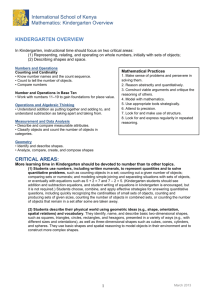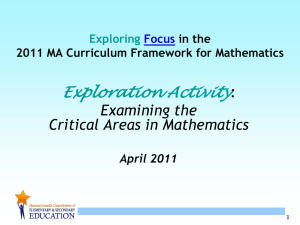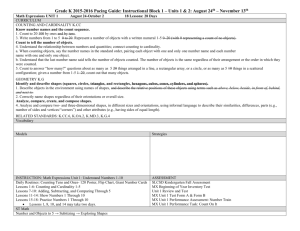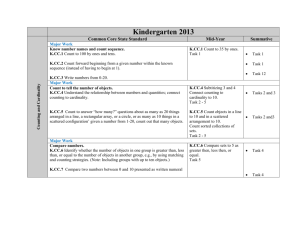This document is designed to help North Carolina educators teach...
advertisement
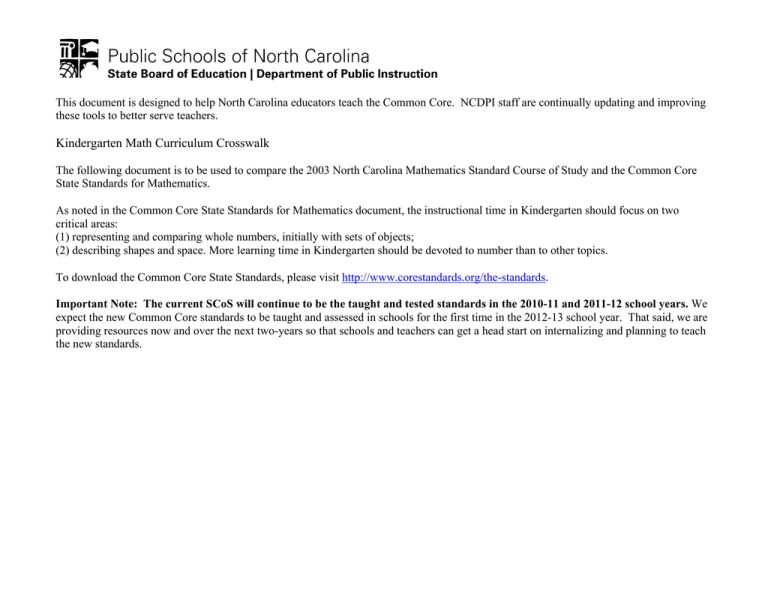
This document is designed to help North Carolina educators teach the Common Core. NCDPI staff are continually updating and improving these tools to better serve teachers. Kindergarten Math Curriculum Crosswalk The following document is to be used to compare the 2003 North Carolina Mathematics Standard Course of Study and the Common Core State Standards for Mathematics. As noted in the Common Core State Standards for Mathematics document, the instructional time in Kindergarten should focus on two critical areas: (1) representing and comparing whole numbers, initially with sets of objects; (2) describing shapes and space. More learning time in Kindergarten should be devoted to number than to other topics. To download the Common Core State Standards, please visit http://www.corestandards.org/the-standards. Important Note: The current SCoS will continue to be the taught and tested standards in the 2010-11 and 2011-12 school years. We expect the new Common Core standards to be taught and assessed in schools for the first time in the 2012-13 school year. That said, we are providing resources now and over the next two-years so that schools and teachers can get a head start on internalizing and planning to teach the new standards. Common Core Crosswalk Document Math: Kindergarten Standard Text of objective Common Core Domain Object Strand NC SCOS Cluster Text of objective Comments K.CC.1 K.CC. 2 K.CC. 4 K.CC.4.b K.CC.4.a b) Count objects in a set. Counting & Cardinality 1.01 Number & Operations a) Connect model, number word (orally), and number, using a variety of representations. Counting & Cardinality Develop number sense for whole numbers through 30. Know number names and the count sequence. Count to 100 by ones and tens. Specificity on the counting processes has been added. Know number names and the count sequence. Count forward beginning for a given number within the known sequence (instead of having to begin at 1). Count to tell the number of objects. Understand the relationship between numbers and quantities; connect counting to cardinality. Involves the rote counting Count to tell the number of objects. sequence, and one-to-one tagging. Understand the relationship between numbers and quantities; connect counting to cardinality. a. When counting objects, say the number names in the standard order, pairing each object with one and only one number name and each number name with one and only one object. Describes cardinality. Count to tell the number of objects. Understand the relationship between numbers and quantities; connect counting to cardinality. b. Understand that the last number name said tells the number of objects counted. The number of objects is the same regardless of their arrangement or the order in which they were counted. Page 2 of 8 NC DPI 3/31/2011 Common Core Crosswalk Document Math: Kindergarten Standard K.CC.5 K.CC.3 c) Read and write numerals. Domain Text of objective Common Core Counting & Cardinality Object Strand NC SCOS K.CC.6 K.CC.7 Counting & Cardinality d) Compare and order sets and numbers. Cluster Text of objective Comments Students count to 30 in NC SCOS. Count to tell the number of objects. Understand the relationship between numbers and quantities; connect counting to cardinality. c) Count to answer “how many?” questions about as many as 20 things arranged in a line, a rectangular array, or a circle; or as many as 10 things in a scattered configuration; given a number from 1-20, count out that many objects. Know number names and the count sequence. Write numbers from 0 to 20. Represent a number of objects with a written numeral 0-20 (with 0 representing a count of no objects). Include groups with up to ten Compare numbers. objects. Identify whether the number of objects in one group is greater than, less than, or equal to the number of objects in another group, e.g., by using matching and counting strategies. Compare numbers. Compare two numbers between 1 and 10 presented as written numerals. e) Use ordinals (1st-100th). f) Estimate quantities fewer than or equal to 10. Page 3 of 8 NC DPI 3/31/2011 Common Core Crosswalk Document Math: Kindergarten g) Recognize equivalence in sets and numbers 1-10. Standard Domain Text of objective Common Core Operations & Algebraic K.OA. 3 Object Strand NC SCOS Cluster Text of objective Comments Understand addition as putting together and adding to, For example, 6 + 3 is the same as and understand subtraction as taking apart and taking 9, as well as 5 + 4. from. Decompose numbers less than or equal to 10 into pairs in more than one way, e.g. by using objects or drawings, and record each decomposition by a drawing or equation. Moved to first grade in Common Core. Counting & Cardinality K.CC.4 1.03 Solve problems and share solutions to problems in small groups. Operations & Algebraic Thinking K.OA.2 1.02 Share equally (divide) between two people; explain. Understand addition as putting together and adding to, and understand subtraction as taking apart and taking from. Solve addition and subtraction word problems, and add and subtract within 10 e.g. by using objects or drawings to represent the problem. Count to tell the number of objects. Understand that each successive number name refers to a quantity that is one larger. Page 4 of 8 NC DPI 3/31/2011 Common Core Crosswalk Document Math: Kindergarten Operations & Algebraic Thinking Standard K.OA.1 K.OA.4 Cluster Text of objective Comments Understand addition as putting together and adding to, 2Drawings need not show details, and understand subtraction as taking apart and taking but should show the mathematics in the problem. from. Represent addition and subtraction with objects, fingers, mental images, drawings2, sounds (e.g. claps), acting out situations, verbal explanations, expressions, or equations. Understand addition as putting together and adding to, and understand subtraction as taking apart and taking from. For any number from 1 to 9, find the number that makes 10 when added to the given number, e.g., by using objects or drawings, and record the answer with a drawing or equation. Understand addition as putting together and adding to, and understand subtraction as taking apart and taking from. Fluently add and subtract within 5. K.OA.5 Domain Text of objective Common Core Operations & Algebraic Thinking Object Strand NC SCOS “Fluently” does not necessarily mean “memorize.” In kindergarten, it would still be appropriate for students to use fingers to count (the use of the fingers helps develop subitizing skills), a five or ten frame, or other visual aids. These facts include: 1+1, 1+2, etc. up to 4+1 and 5+0. Page 5 of 8 NC DPI 3/31/2011 Common Core Crosswalk Document Math: Kindergarten Standard K.MD.1 K.MD.2 Domain Numbers & Operations in Base Ten K.NBT.1 Describe and compare measurable attributes. Describe measurable attributes of objects, such as length or weight. Describe several measurable attributes of a single object. Describe and compare measurable attributes. Directly compare two objects with a measurable attribute in common, to see which object has “more of”/ “less of” the attribute, and describe the difference. Comments Recognize concepts of calendar time using appropriate vocabulary (days of the week, months of the year, seasons). Identify, build, draw, and name triangles, rectangles, and circles; identify, build, and name spheres and cubes. K.G.2 3.01 Geometry 2.02 Measurement 2.01 Compare attributes of two objects using appropriate vocabulary (color, weight, height, width, length, texture. Cluster Text of objective Work with numbers 11-19 to gain foundations for place value. Compose and decompose numbers from 11-19 into ten ones and further ones, e.g., by using objects or drawings, and record each composition or decomposition by a drawing or equation (such as 18= 10 + 8); understand that these numbers are composed of ten ones, and one two, three, four, five, six, seven, eight, or nine ones. Measurement & Data Text of objective Common Core Geometry Object Strand NC SCOS Identify and describe shapes (squares, circles, triangles, Added identification of squares, hexagons, cones and cylinders. rectangles, hexagons, cubes, cones, cylinders, and spheres). Correctly name shapes regardless of their orientations or overall size. Page 6 of 8 NC DPI 3/31/2011 Common Core Crosswalk Document Math: Kindergarten Standard Text of objective Common Core Domain Object Strand NC SCOS 3.02 K.G.4 Compare geometric shapes (identify likenesses and differences). K.G.5 K.G.3 K.G.6 Complete simple spatial visualization tasks and puzzles. Geometry 3.04 3.03 K.G.1 Model and use directional and positional vocabulary. Cluster Text of objective Comments Analyze, compare, create, and compose shapes. Analyze and compare a variety of two- and threedimensional shapes, in different sizes and orientations, using informal language to describe their similarities, differences, parts (e.g., number of sides and vertices/ “corners”) and other attributes (e.g., having sides of equal length). Identify and describe shapes (squares, circles, triangles, rectangles, hexagons, cubes, cones, cylinders, and spheres). Describe objects in the environment using names of shapes, and describe the relative positions of these objects using terms such as above, below, beside, in front of, behind, and next to. Analyze, compare, create and compose shapes. Compose simple shapes to form larger shapes. Identify and describe shapes (squares, circles, triangles, The identification of the qualities that makes an object or drawing rectangles, hexagons, cubes, cones, cylinders, and two-dimensional or threespheres). dimensional is new to Identify shapes as two-dimensional (lying in a plane, Kindergarten. “flat”) or three-dimensional (“solid”). Analyze, compare, create, and compose shapes. Model shapes in the world by building shapes from components (e.g., sticks and clay balls) and drawing shapes. Page 7 of 8 NC DPI 3/31/2011 Common Core Crosswalk Document Math: Kindergarten 5.02 Standard Domain Comments K.MD.3 Sort and classify objects by one attribute. Cluster Text of objective 3 Limit category counts to be less Classify objects and count the number of objects in than or equal to 10. each category. Classify objects into given categories; count the number of objects in each category and sort the categories by count.3 K.MD.3 Algebra Display and describe data with concrete and pictorial graphs as a group activity. Common Core Measurement & Data Object 4.01 Collect and organize data as a group activity. 4.02 Text of objective 5.01 Data Analysis & Probability Strand NC SCOS Classify objects and count the number of objects in each category. Classify objects into given categories; count the number of objects in each category and sort the categories by count. Create and extend patterns with actions, words and objects. Page 8 of 8 NC DPI 3/31/2011
